Seizures of drugs in England and Wales, financial year ending 2021
Updated 4 February 2022
Applies to England and Wales
Frequency of release: Annual
Forthcoming release: Home Office statistics release calendar
Home Office responsible statistician: Amy Baxter
Public enquires: [email protected]
This statistical release presents figures for drug seizures made in the year ending 31 March 2021 in England and Wales by the police (including the British Transport Police) and Border Force. The data relate to all drugs controlled under the Misuse of Drugs Act 1971 (MDA). The MDA divides drugs into three categories - Classes A, B and C – according to how much harm their misuse causes to the user, or to society - with Class A drugs seen as the most harmful. This statistical release also presents figures relating to drugs known as new psychoactive substances (NPS).
Key results
- police forces and Border Force made a total of 223,106 drug seizures in England and Wales in year ending March 2021, a 21% increase compared with the previous year (183,646); this is the third consecutive annual increase in seizures, reversing a downward trend since year ending March 2012
Number of seizures of Class A, B and C drugs, police forces and Border Force, years ending March 2007 to 2021

- seizures of Class A drugs by police forces and Border Force increased by 17% between years ending March 2020 and 2021
- seizures of cocaine by police forces and Border Force decreased by 6% from year ending March 2020 but the quantity of cocaine seized increased by 161% (6,874kg) from 4,274kg in that year to 11,148kg in the latest year
- seizures of crack by police forces and Border Force increased by 2% since year ending March 2020, the highest number of seizures since year ending March 2008. The quantity of crack seized decreased by 43%
- seizures of Class B drugs increased by 21% between years ending March 2020 and 2021 with 95% of all Class B seizures involving at least one form of cannabis
Executive summary
This statistical release presents figures for drug seizures made in the year ending 31 March 2021 in England and Wales by the 44 police forces (including the British Transport Police) and Border Force. The data relate to all drugs controlled under the Misuse of Drugs Act 1971 (MDA). This divides drugs into three categories - Classes A, B and C - according to the harm their misuse cause to the user, or to society - with Class A drugs seen as the most harmful.
The number and quantity of seizures made can be affected by police and Border Force activity and changes in recording practices, as well as changes in the drugs market. Therefore, the number and quantity of drug seizures each year should not be taken as an indicator of drug prevalence in England and Wales. The coronavirus (COVID-19) pandemic, and subsequent lockdowns in England and Wales, are likely to have affected indicators in this report, such as changes to the night-time economy and associated drug use, or changes in police and Border Force activity.
Three police forces (Hertfordshire Constabulary, Kent Police and Staffordshire Police) could not provide complete data for year ending March 2021, in time for the publication. Imputation methods have been used to estimate data for these forces. Improvements have also been made to data processing and analysis methods for this year’s report. Further details can be found in the user guide.
Key findings
- a total of 223,106 drug seizures were made in England and Wales in the year ending March 2021, a 21% increase compared with the previous year (183,646); this is the third consecutive annual increase in seizures, reversing a declining trend since the year ending March 2012; increases in the number of seizures of Class B drugs seem to have driven the overall increase in seizures; there were also notable increases in seizures of Class A drugs such as LSD, methadone and ‘other Class A’ drugs, as well as Class C drugs overall
- there were increases in the number of seizures made by police forces (up by 17% from 169,802 to 198,361) and by Border Force (up 79% from 13,844 to 24,745)
- cannabis was the most commonly seized drug; the three main types of cannabis (herbal, plant, and resin) were involved in 71% of all drug seizures in England and Wales, in the year ending March 2021
- after cannabis, cocaine was the next most frequently seized drug; this was involved in 8% of all seizures; however, cocaine seizures have seen a 6% decline this year, the first reduction since year ending March 2017
- trends in the number of seizures were driven by police force activity, as the vast majority (89%) were made by them
- while Border Force seizures made up a small proportion of the total number of seizures, they tended to comprise much larger quantities; this reflects that seizures made by police forces are dominated by the apprehending of individuals with smaller quantities of drugs, for example for personal consumption, whereas Border Force will catch those involved in the trafficking of larger quantities for supply; for example, in terms of quantity, Border Force seized 98% of GHB, 97% of temazepam, 92% of heroin, 90% of anabolic steroids, 85% of cocaine
Class A
- seizures of Class A drugs increased by 17% between the years ending March 2020 and 2021, from 37,371 to 43,586 seizures; of the Class A drugs, cocaine was seized most often, with 40% of all Class A seizures involving this substance in the year ending March 2021
- there were 17,641 seizures of cocaine in the year ending March 2021, down by 6% compared to the previous year (18,736 seizures); however, the quantity of cocaine seized increased by 161% (6,874kg) from 4,274kg in the year ending March 2020, to 11,148kg in 2021; the quantity of cocaine seized in the year ending March 2019 was also particularly large, at 9,648kg; prior to year ending March 2019, the quantity of cocaine seized annually had ranged from 2,387kg to 5,520kg
- after cocaine, heroin was the second most commonly seized Class A drug (21% of Class A seizures); there were 9,258 seizures in the year ending March 2021, a 6% increase on the previous year’s total of 8,769 seizures; however, the quantity of heroin decreased by 18% from 2,396kg seized in the previous year to 1,973kg; the decrease in quantity was largely driven by a reduction in the amount seized by Border Force
- in the year ending March 2021, 1.4 million doses of ecstasy were seized; this is a 41% decrease from the 2.36 million doses seized in the year to March 2020, but is more in line with the longer-term trend, as 2019 and 2020 were the highest quantities seized since the year to March 2015
- 145,140 doses of LSD were seized in the year ending March 2021, a 19% decrease compared with the previous year (180,140 doses); more LSD was seized in 2020 than in any single year since the year ending March 2005, when 1.14 million doses were recorded; statistics on historical seizures of drugs in England and Wales can be found in the web archive
- despite contrasting with the overall increase in drug seizures, in year ending March 2021, the decreases in the quantities of ecstasy and LSD seized, could be partly due to the COVID-19 ‘lockdown’ regulations imposed during 2020-21, involving the banning of large gatherings, closures of nightclubs and music venues, and cancellation of festivals, for example; this indicates that these factors had a more significant effect on seizures of LSD and ecstasy, than of those of other drug categories in drug seizures in year ending march 2021
- seizures of crack by police forces and Border Force increased by 2%, from 7,070 in the year ending March 2020, to 7,233 in the latest year, the highest number of seizures since the year ending March 2008; however, the quantity of crack seized decreased by 43%, from 84kg in the year ending March 2020, to 48kg in the latest year; more crack had been seized in 2020 than in any single year since the year ending March 2004; statistics on historical seizures of drugs in England and Wales can be found in the web archive.
- there were 31 seizures of fentanyl and 6 seizures of fentanyl analogues, by police forces and Border Force, in the year ending March 2021; this is the third year that data on fentanyl seizures have been published separately, in addition to their inclusion within the ‘Other Class A drugs’ category
Class B
- seizures of Class B drugs increased by 21% between the years ending March 2020 and 2021, from 139,129 to 168,332 seizures; cannabis was seized more often than any other Class B drug, with 95% of all Class B seizures involving this substance, in the year ending March 2021
- approximately 89% of cannabis seizures involved herbal cannabis; between the years ending March 2020 and 2021, the number of seizures of herbal cannabis rose by 21%, from 116,611 to 141,557 seizures
- the quantity of herbal cannabis seized decreased by 16% compared with the previous year, from 20,549kg in the year ending March 2020, to 17,213kg in 2021
- there was an 119% increase in the quantity of cannabis resin seized, from 908kg to 1,990kg, between years ending March 2020 and 2021; the number of cannabis plants seized increased by 64%, from 500,448 plants to 818,812 plants
Class C
- seizures of Class C drugs increased by 55% between the years ending March 2020 and 2021, from 5,789 to 9,001 seizures; ‘Other Class C’ drugs (e.g. Tramadol, Zopiclone, Khat) were the most commonly seized Class C drugs, in the year ending March 2021, with 4,565 seizures; this was a 58% increase on the previous year
- between the years ending March 2020 and 2021, the quantity of benzodiazepines seized, decreased by 57%, from 1.15 million to 492,710 doses
- there was a 20% increase in the quantity of anabolic steroids seized between the years ending March 2020 and 2021, from 1.36 million to 1.64 million doses
New psychoactive substances (NPS)
- the combined total of NPS seizures for year to March 2021 was 4,104 (3,289 by police forces, and 815 by Border Force); seizures of NPS by police forces in the year ending March 2021 increased by 18%, from 2,794 in the previous year
- seizures of NPS Other, by police forces and Border Force, almost doubled between the year to March 2020 and the year to March 2021 with total seizures for NPS Other increasing by 88%, from 649 to 1,220 seizures
- police forces made 2,162 seizures of synthetic cannabinoids, more than for other types of NPS, in the year ending March 2021; there were 640 seizures of NPS Other, 173 seizures of NPS powders, and 314 seizures of nitrous oxide
- comparisons to March 2020 are not possible for Border Force as totals for NPS and synthetic cannabinoids were not available as separate figures last year; for comparison purposes, they are reported separately for March 2021
1. Introduction
This publication presents figures for drug seizures made in the year ending March 2021 in England and Wales by the territorial police forces (and the British Transport Police) and Border Force. Although Border Force will have made seizures outside the land territory of England and Wales (e.g. Scotland, Northern Ireland) such seizures are excluded from figures presented in this publication.
Drug seizures often involve the seizure of multiple types of drugs. This means that the sum of seizures by each drug type will exceed the overall number of seizures. For example, if cocaine and cannabis resin were both seized in one seizure, this would be counted as one seizure in the overall total but would be counted twice in the breakdown by drug type (one seizure of cocaine plus one seizure of cannabis resin).
This publication reports on trends in drug seizures across England and Wales for the year ending March 2021. The coronavirus (COVID-19) pandemic, and subsequent lockdowns in England and Wales, are likely to have affected indicators in this report, but potentially in complex ways, such as changes to the night-time economy and associated drug use, or changes in police and Border Force activity. For crime overall, the Home Office’s Crime Outcomes in England and Wales 2020 to 2021, published 22nd July 2021, shows that whilst total police recorded crime (excluding fraud) fell by 13%, there was a 13% increase in drug offences compared with the previous year. The Office for Health Improvement & Disparities report Adult substance misuse treatment statistics 2020 to 2021 considered COVID-19’s impacts on treatments available for drug users and found that overall the number of service users during the reporting period increased slightly, but the nature of service delivery varied.
In the year ending March 2018, figures for seizures of drugs referred to as new psychoactive substances (NPS) were presented in this publication for the first time. NPS refers to newly available drugs that mimic the effect of existing drugs such as cannabis, ecstasy, and powder cocaine. Some NPS are controlled under the Misuse of Drugs Act 1971 (MDA). Some other types of NPS may be illegal to supply, produce and import under the Psychoactive Substances Act (PSA) 2016. The year ending March 2018 was the first year that data on NPS had been recorded systematically across police forces and Border Force. However, Border Force could not provide separate figures for total NPS and synthetic cannabinoids seizures in the year ending March 2020. Data is presented for the years ending March 2020 and 2021, however these statistics remain designated as Experimental Statistics, as they are not yet fully developed and do not meet the rigorous quality standards of National Statistics.
Three police forces (Hertfordshire Constabulary, Kent Police and Staffordshire Police) could not provide fully accurate data for the year ending March 2021, in time for the publication. As a result, imputation methods have been used to estimate data for these forces, as outlined in the user guide. All comparisons in this publication include the estimated values.
In preparing the data for this publication, we have improved our data processing and analysis methods. This process has resulted in the discovery of some historical errors in earlier years’ data and estimates. We have corrected these errors, and therefore some of the previous years’ figures will differ from previous years’ reports. The user guide explains these changes further.
Data on the number of seizures and quantity of drugs seized in England and Wales can be found in the accompanying spreadsheet tables. Please also note that seizures data for Border Force include data from HM Revenue and Customs (HMRC) up to and including year ending March 2011.
1.1 Substances covered by this release
The statistics covered by this release relate to all drugs controlled under the Misuse of Drugs Act 1971 (MDA). This divides drugs into three categories - Classes A, B and C – according to the harm their misuse causes to the user, or to society - with Class A drugs seen as the most harmful. Given the large number of drugs covered by the Misuse of Drugs Act 1971 (MDA), it is not feasible to publish seizure statistics in detail for every drug type. While all drugs are included in the totals, only those shown below are covered in detail within this bulletin. Where a seizure is made of a drug that is not listed in the table below, it is aggregated into an ‘other’ class category. Further information on drugs covered under the MDA is provided in the government’s controlled drugs list. This bulletin also captures the number of seizures where the substance, and therefore its classification, were unknown.
List 1: Drugs and their classifications under MDA 1971
Class A
Cocaine
Crack
Ecstasy
Heroin
LSD
Methadone
Morphine
Class B
Amphetamines*
Barbiturates**
Cannabis**
Ketamine***
Mephedrone
Class C
Anabolic steroids
Benzodiazepines
GHB
Temazepam
Notes:
* Amphetamines and barbiturates are Class A drugs if prepared for injection.
** Cannabis was reclassified from a Class B to a Class C drug in January 2004, and then classified back to a Class B drug on 26 January 2009. Cannabis is counted as a Class B drug for the entire time series in this publication.
*** Ketamine was reclassified from a Class C to a Class B drug on 10 June 2014. Ketamine is counted as a Class B drug for the entire time series in this publication.
For consistency, drugs are counted against their current classification for all years shown. For example, cannabis is counted as a Class B drug for the entire time series.
This is the fourth year that information on seizures of NPS are covered in this publication, and the third year that fentanyl and fentanyl analogues are reported separately, in addition to their inclusion within the ‘Other Class A drugs’ category.
As with previous years, Border Force have not reported separately some of the drugs included in the above table. This has resulted in Border Force seizures of methadone being included within the ‘Other Class A’ grouping; synthetic cannabinoids and barbiturates within ‘Other Class B’; and benzodiazepines, GHB and temazepam within ‘Other Class C’.
2. Number of seizures
- in the year ending March 2021, there were 223,106 seizures of drugs in England and Wales, a 21% increase from the previous year, when there were 183,646 seizures
- this is the third consecutive annual increase in seizures, reversing a declining trend since the year ending March 2012; there were increases in the number of seizures of Class B drugs, especially herbal cannabis, and this has driven the overall increase in seizures; however, there were also notable increases in seizures of Class A drugs such as LSD, methadone and ‘other Class A’ drugs; there were also increases in Class C drugs overall, despite the proportionately lower volume of Class C drugs seized, relative to Class B
- as in previous years, most seizures were for Class B drugs, and in particular cannabis; nearly three-quarters (71%) of all seizures involved cannabis (herbal, resin, or plants)
- after cannabis, cocaine was the next most frequently seized drug; this was involved in 8% of all seizures; however, cocaine seizures have seen a 6% decline this year, the first reduction since year ending March 2017
Figure 1: Number of seizures of Class A, Class B and Class C drugs, police forces and Border Force, years ending March 2007 to 2021

Source: Home Office, Summary Table 1.
Chart notes
* For consistency, drugs are counted in their current classification for the entire time series shown.
The number of seizures made can be affected by police activity and changes in recording practices. Therefore, the number of drug seizures each year should not be taken as a measure of drug prevalence in England and Wales. Prevalence is presented in the Drug Misuse: Findings from the 2019 to 2020 CSEW publications, based on results from the Crime Survey in England and Wales, and the Smoking, Drinking and Drug Use among Young People in England.
The total number of drug seizures per year follows a similar trend to the number of police recorded drug offences (Figure 2). Statistics on the number of police recorded drug offences are published on a quarterly basis by the Office of National Statistics (ONS) - please see Crime in England and Wales, year ending March 2021. In the year ending March 2021, the police recorded 209,581 drug offences, a 14% increase from the previous year (183,560). This includes offences for possession of controlled drugs, trafficking in controlled drugs, and other drug offences. Over the same period, the number of seizures by police forces alone, excluding Border Force, also increased by 17%. Other statistics, on Police powers and procedures, show an increase in stop and search compared to the previous year. But the report also notes that reductions in demand for calls to service (in part due to the COVID-19 pandemic) created capacity for more proactive policing which some forces reportedly used to target drug dealers and county lines. This may be part of the reason for the increase in drug searches across the latest year. Since the peak in the year ending March 2009, the number of drug offences recorded by the police has decreased by 14%, from 243,536 to 209,581, and the number of drug seizures by police forces has also decreased by 15%, from 233,793 to 198,361.
Figure 2: Index of police recorded drug offences and the total number of drug seizures by police forces, years ending March 2007 to 2021

Source: Home Office, Summary Table 1. Office for National Statistics (ONS), Crime in England and Wales, year ending March 2021, Appendix Table A4.
2.1 Class A drugs
In the year ending March 2021, there were 43,586 seizures of Class A drugs, a 17% increase on the previous year (37,371 seizures). In the latest year, 20% of all drug seizures involved at least one Class A drug. Since the year ending March 2007, cocaine has been the most frequently seized Class A drug, followed by heroin. Statistics on historical seizures of drugs in England and Wales can be found in the web archive
- 40% of all seizures of Class A drugs involved cocaine, with 17,641 seizures in the year ending March 2021, a 6% decrease on the previous year’s figure (18,736); as shown in Figure 3, the number of cocaine seizures had followed a downward trend, since the peak in the year ending March 2009, until the year ending March 2017; since then, numbers have generally been increasing, peaking again at 18,736 seizures last year
- after cocaine, heroin was the second most commonly seized Class A drug, with 9,258 seizures in the year ending March 2021, a 6% increase on the previous year’s total of 8,769 seizures, as shown in Figure 3; this represented 21% of all Class A seizures
- apart from cocaine and ecstasy, seizures of all Class A drugs increased, as follows:
- crack seizures were up 2% from 7,070 in the year ending March 2020, to 7,233 in the latest year, the highest number since the 7,191 seizures in the year ending March 2008, as shown in Figure 3; almost all the crack seizures were made by police forces; Border Force tend to make fewer seizures of crack than police forces – and at much lower quantities - because most crack is made in England and Wales from imported powder cocaine
- other Class A seizures were up 134%, from 3,608 to 8,441
- LSD seizures more than quadrupled - up 315% from 518 to 2,148; this was the highest since 2000, when there were 240 seizures
- morphine seizures were up 42%, from 178 to 252
- methadone seizures doubled - up 101% from 419 to 841
- the number of ecstasy seizures decreased by 7%, from 3,563 to 3,316
Figure 3: Number of seizures of the main Class A drug types, police forces and Border Force, years ending March 2007 to 2021

Source: Home Office, Summary Table 1.
-
there were 31 seizures of fentanyl and 6 seizures of fentanyl analogues in the year ending March 2021, as shown in Figure 4
-
fentanyl data from years ending March 2007 to 2018 excludes Sussex, as reliable data was not available
Figure 4: Number of seizures of fentanyl and fentanyl analogues, by police forces and Border Force, years ending March 2012 to 2021
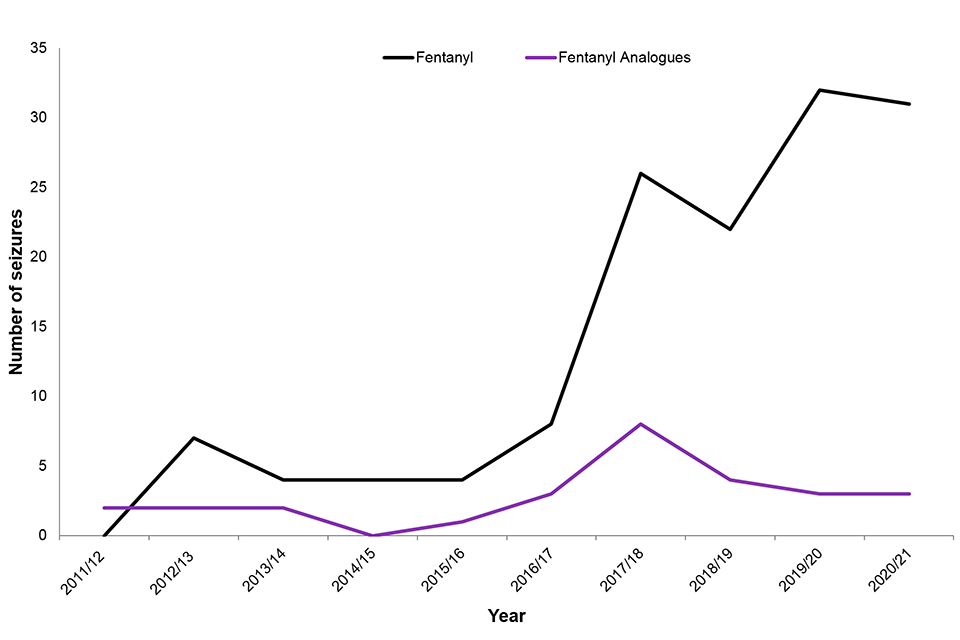
Source: Home Office, Appendix Table 3.
2.2 Class B drugs
In the year ending March 2021, there were 168,332 seizures of Class B drugs, a 21% increase compared with the previous year (139,129 seizures). As in previous years, the great majority of Class B seizures were for cannabis, with 95% (159,209) of all Class B seizures involving at least one form of cannabis.
2.2.1 Cannabis
- there were 159,209 seizures of cannabis in the year ending March 2021, a 22% increase from the previous year (130,891)
- cannabis seizures have increased each year since the year ending March 2018, following a general decline in cannabis seizures since the year ending March 2012, as shown in Figure 5
- approximately 89% of cannabis seizures involved herbal cannabis; the number of herbal cannabis seizures increased by 21%, from 116,611 to 141,557, between the years ending March 2020 and 2021
- seizures of cannabis resin increased by 11%, from 7,901 to 8,779; seizures of cannabis plants increased by 28%, from 9,219 to 11,779
Figure 5: Number of cannabis seizures, police forces and Border Force, years ending March 2007 to 2021
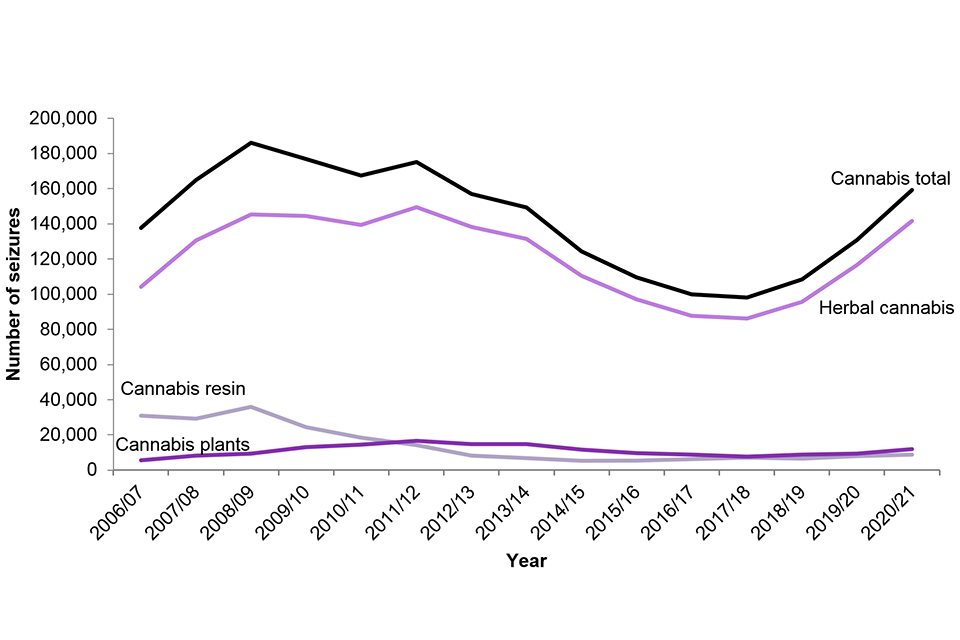
Source: Home Office, Summary Table 1.
2.2.2 Other Class B drugs
- in the year ending March 2021, there were 4,294 seizures of amphetamines, a 22% increase on the previous year when there were 3,522 seizures; previously, amphetamine seizures had declined by 58%, from 8,414 seizures in the year ending March 2008, to 3,522 seizures in the year ending March 2020
- in the year ending March 2021, there were 1,519 seizures of ketamine, a 21% increase on the previous year, when there were 1,255 seizures; this increase includes a 191% increase in seizures by Border Force to 538 seizures, up from 185 in the previous year; Border Force believe that the increase may be due to an increase in demand for ketamine, so the increase may reflect increased activity in this area
- seizures of ‘Other Class B’ drugs were the second most frequently seized Class B drug, with 5,084 seizures in the year ending March 2021, slightly higher than in the previous year (5,071)
- mephedrone (non-injection) seizures decreased by 5%, from 75 in the year ending March 2020, to 71 in the latest year; there has been a long-term decline since the year ending March 2013, when there were 3,874 mephedrone seizures
2.3 Class C drugs
- seizures of Class C drugs increased by 55%, between the years ending March 2020 and 2021, from 5,789 to 9,001 seizures
- ‘other Class C’ drugs were seized more often than any other Class C categories, in the year ending March 2021, with 4,565 seizures; this was a 58% increase on the previous year’s figure (2,885)
- examples of ‘Other Class C’ drugs include Tramadol, Zopiclone and Khat; Border Force also include Benzodiazepines, GHB and Temazepam in the ‘Other Class C’ category
- 40% of all seizures of Class C drugs involved benzodiazepines, with the number of seizures increasing by 62%, from 2,233 in year ending March 2020, to 3,628 in year ending March 2021
2.4 Unknown substances
In the year ending March 2021, the number of seizures of unknown substances increased by 17%, compared with the previous year, from 13,419 to 15,697. Where a drug is described as ‘unknown’ or ‘drug not known’, this generally means that they have seized substances which they cannot easily identify, and may need to send to a specialist laboratory for further analysis. Sometimes quantities are too small to justify this process, but if they are later identified, the force can provide a revised update.
3. Quantity of drugs seized
The quantity of drugs seized tends to fluctuate from year to year, and trends do not necessarily move in line with the number of seizures made. Annual totals of the quantity of drugs seized can be greatly influenced by a small number of large seizures. As with the number of drug seizures, any large quantity of drugs seized should not be taken as an indication of drug prevalence or availability.
The quantities of drugs seized are summarised in terms of kilograms, doses (in thousands) or plants, as shown in List 2.
List 2: Drugs summarised in kilograms, doses, and plants
Summarised in kilograms
Amphetamines
Herbal cannabis
Cannabis resin
Cocaine
Crack
GHB
Heroin
Ketamine
Summarised in doses*
Anabolic steroids
Barbiturates
Benzodiazepines
Ecstasy
LSD
Methadone
Morphine
Temazepam
Summarised as plants
Cannabis plants
* In the data tables these are presented in thousands of doses (000s).
Most drugs can plausibly be seized in a preparation form other than kilograms or doses. In order to present all seized quantities within a given drug type in terms of one comparable unit - either kilograms or doses - conversion factors are applied to estimate the overall quantity of drugs seized. The quantities of fentanyl and fentanyl analogues have not been converted into one comparable unit, as an accurate conversion factor could not be identified. Please refer to the user guide for more information.
3.1 Class A drugs
3.1.1 Cocaine, heroin, and crack
- in the year ending March 2021, 11,148kg of cocaine were seized by police forces and Border Force; this was a 161% increase of 6,874kg, from 4,274kg in the previous year, see Figure 6; the quantity of cocaine seized in the years to March 2019 and 2021 were particularly large, with 9,648kg seized in 2019; prior to year ending March 2019, the quantity of cocaine seized annually had ranged from 2,387kg to 5,520kg
- Border Force seized 9,460kg of cocaine, in the year ending March 2021 (85% of total seizures); this was an increase of 152% from 5,705kg in the year to March 2020; the quantity of cocaine seized by police forces more than trebled, from 519kg in the year to March 2020, to 1,688kg in the year to March 2021
- the total quantity of heroin seized in the year ending March 2021 was 1,973kg, an 18% decrease from the 2,396kg seized in the previous year, as shown in Figure 6
- the decrease was largely driven by an 18% reduction in the amount of heroin seized by Border Force, from 2,210kg in year ending March 2020 to 1,812kg in the latest year
- there was a 13% decrease (185kg to 161kg) in the amount of heroin seized by police forces
- 48kg of crack was seized by police forces and Border Force in the year ending March 2021, 43% less than the 84kg seized in the previous year; the 84kg seized in 2020, had been the highest amount since the year ending March 2004, when 140kg of crack were seized
- Border Force seized an unusually high volume (34kg) of crack in the year ending March 2020, due mainly to two large crack seizures of between 10kg and 100kg in that year; the quantity of crack seized by Border Force tends to be small, because most crack is made in England and Wales from imported powder cocaine; hence the total seized by Border Force in the year to March 2021, 0.06kg, is closer to earlier years’ figures, including the 0.03kg seized in the year to March 2019
Figure 6: Quantity of cocaine and heroin seized, police forces and Border Force, years ending March 2007 to 2021

Source: Home Office, Summary Table 2
- as shown in Figure 7, 58% of heroin seizures in the year ending March 2021 weighed under 1g, 40% weighed from 1g to <500g, and the remaining 2% weighed 500g or more; the distributions of cocaine seizures by weight were similar, with 56% under 1g, 42% from 1g to <500g, and the remaining 2% weighing 500g and over; for crack seizures, 61% weighed under 1g, 39% weighed from 1g to <500g, and 0% weighed 500g and over (1 seizure); chapter 4 covers the quantities of drugs seized by the authority making the seizures
Figure 7: Distribution of quantities of Class A drugs seized, summarised in grams, police forces and Border Force, year ending March 2021

Source: Home Office, Summary Table 3. Numbers may not sum to 100% due to rounding.
3.1.2 Other Class A drugs
- the quantity of ecstasy seized, declined by 41% from 2.36 million to 1.4 million doses, between the years ending March 2020 and 2021; this followed increases in the quantity of ecstasy seized since year ending March 2017, when 498,120 doses were seized; the increases from 2017 were largely driven by increases in Border Force seizures; the total quantity of ecstasy seized by police forces and Border Force in the year to March 2020 was among the highest since year ending March 2007
- as shown in Figure 8, 50% of ecstasy seizures in the year ending March 2021 involved 10 or fewer doses, 24% involved over 10 doses, and 25% were of unknown quantity; the seizures where the quantity was unknown, were all reported by Border Force; they have indicated that it is sometimes difficult to quantify the number of doses, when seizing ecstasy in some forms, for example powders, crystals or liquids
- seizures of LSD by police forces and Border Force decreased by 19%, from 180,140 doses in the year ending March 2020, to 145,140 in the year ending March 2021; this could partly be attributed to the unusually high level of LSD seizures in the year to March 2020, which could be largely explained by an increase in the quantity seized by Merseyside Police, who seized 154,599 doses of LSD in the year ending March 2020; this represented 87% of the total amount of LSD seized during that year; there may also have been a reduction in LSD seizures as a result of the lockdown measures resulting from the COVID-19 pandemic
- the quantity of methadone seized increased by 84%, from 43,400 to 79,980 doses, between years ending March 2020 and 2021
- the quantity of morphine seized increased by 57%, from 15,520 to 24,300 doses, between years ending March 2020 and 2021
- a total of 822 doses and 4.16kg of fentanyl and fentanyl analogues, were seized by police forces and Border Force in the year ending March 2021
Figure 8: Distribution of quantities of Class A drugs seized, summarised in doses, police forces and Border Force, year ending March 2021

Source: Home Office, Supplementary Table 2. Numbers may not sum to 100% due to rounding.
3.2 Class B drugs
3.2.1 Cannabis
- the total quantity of herbal cannabis seized in the year ending March 2021 decreased by 16% from the previous year, from 20,549kg to 17,213kg; this follows an increase from 16,699kg in 2019 to 20,549kg in 2020, as shown in Figure 9; most herbal cannabis tends to be seized by Border Force, so large fluctuations in the total amount seized have been mostly driven by Border Force seizures
- the decrease over the last year is driven by a 26% decrease in the quantity of herbal cannabis seized by Border Force, from 15,166kg in the year ending March 2020, to 11,234kg in the latest year; Border Force made 17 seizures of herbal cannabis of 100kg and over in year ending March 2021; by contrast, the quantity of herbal cannabis seized by police forces increased over this period by 11% (5,383kg to 5,980kg)
- the total quantity of cannabis resin seized in the year ending March 2021 more than doubled (increasing by 119%) compared with the previous year, from 908kg to 1,990kg; the quantity of cannabis resin seized by Border Force increased by 122%, from 673kg to 1,492kg; the quantity seized by police forces also increased by 112%, from 235kg to 498kg
- in the year ending March 2021, a total of 818,812 cannabis plants were seized, an increase of 64% from the previous year, when 500,448 plants were seized
Figure 9: Quantity of cannabis seized, police forces and Border Force, years ending March 2007 to 2021
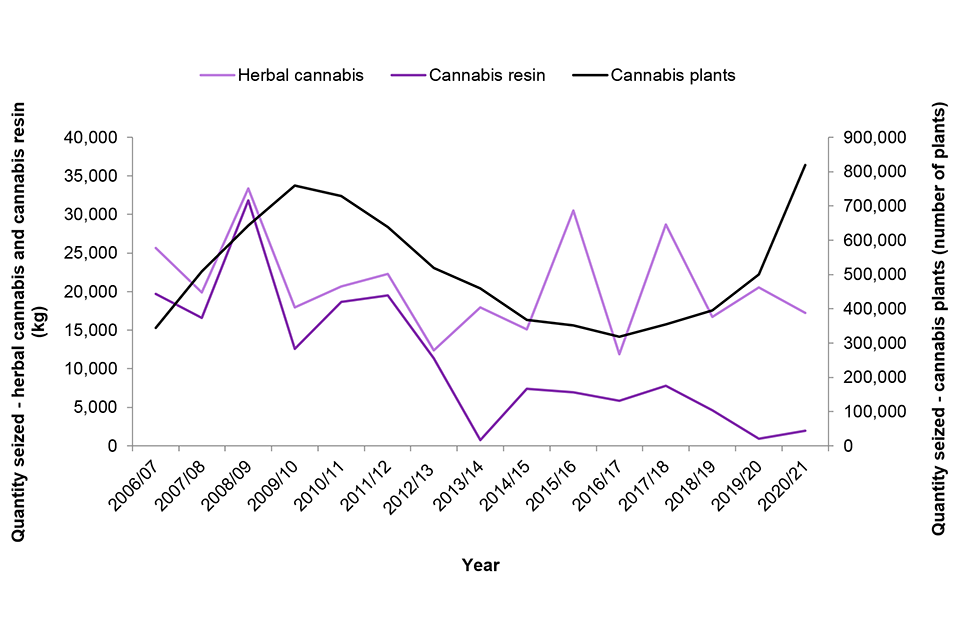
Source: Home Office, Summary Table 2.
- as shown in Figure 10, 12% of cannabis resin seizures in the year ending March 2021 weighed less than 1g, 10% weighed from 1g to <5g, and the remaining 78% weighed 5g or more
- in contrast, 16% of herbal cannabis seizures weighed less than 1g, 56% weighed from 1g to <5g, and 27% weighed 5g and over
Figure 10: Distribution of quantities of herbal cannabis and cannabis resin seized, police forces and Border Force, year ending March 2021
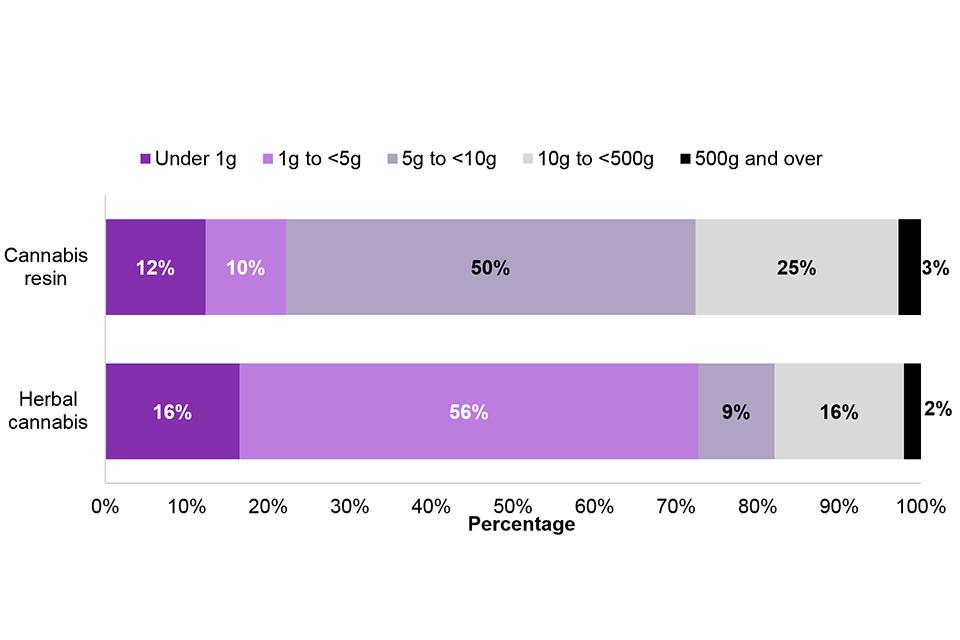
Source: Home Office, Supplementary Table 2. Numbers may not sum to 100% due to rounding.
- as shown in Figure 11, 45% of cannabis plant seizures involved 5 plants or fewer in year ending March 2021, 14% involved 6 to 10 plants, and the remaining 41% involved 11 plants or more
Figure 11: Distribution of quantities of cannabis plants seized, police forces and Border Force, year ending March 2021

Source: Home Office, Supplementary Table 2. Numbers may not sum to 100% due to rounding.
3.2.2 Other Class B drugs
- 187kg of ketamine were seized in the year ending March 2021, a 171% increase from the previous year, when 69kg were seized; this was driven by a 313% increase in the quantity seized by Border Force (from 37kg to 154kg) whereas the quantity seized by police forces increased by 4%, from 32kg to 33kg
- in the year ending March 2021, 305kg of amphetamines were seized, a 33% decrease on the previous year, when 455kg were seized
- in the year ending March 2021, police forces seized 270kg of amphetamines, a 38% decrease on the previous year, when 436kg were seized; by contrast, Border Force seizures of amphetamines increased by 84% between the years ending March 2020 and 2021, from 19kg to 35kg
- as shown in Figure 12, most seizures of ketamine and amphetamines weighed less than 500g, with 35% of ketamine seizures and 44% of amphetamines seizures weighing less than 1g
Figure 12: Distribution of quantities of amphetamines and ketamine seized, police force and Border Force, year ending March 2021

Source: Home Office, Summary Table 3. Numbers may not sum to 100% due to rounding.
3.3 Class C drugs
- the total quantity of anabolic steroids seized increased by 20%, from 1.36 million doses to 1.64 million doses, between years ending March 2020 and 2021; the quantity of anabolic steroids seized by police forces, over the same period, fell from 308,340 doses to 171,140 doses; by contrast, Border Force seizures of anabolic steroids rose by 40%, from 1.06 million to 1.47 million doses
- as shown in Figure 13, 35% of anabolic steroid seizures involved 10 doses or less in the year ending March 2021, 30% involved 11 to 100 doses, 18% involved over 100 doses, and 17% were of unknown quantity
Figure 13: Distribution of quantities of anabolic steroids, police forces and Border Force, year ending March 2021

Source: Home Office, Supplementary Table 2. Numbers may not sum to 100% due to rounding.
- the total quantity of benzodiazepines seized decreased by 57% between the years ending March 2020 and 2021, from 1.15 million doses to 492,710 doses
- these figures for benzodiazepines, are for police forces’ seizures only; from year ending March 2011, seizures of benzodiazepines (like those of methadone, barbiturates, and temazepam) could not be separately identified from the Border Force’s recording system
- there was a 639% increase in the quantity of GHB seized by police forces, from 0.13kg in the year ending March 2020, to 0.93kg in the latest year
- Border Force had not recorded any GHB seizures in the year to March 2020, but in the year to March 2021, they recorded 54.17kg of GHB seizures
- police forces seized 13,800 doses of temazepam, in the year ending March 2021, a 335% increase from the previous year, when 3,170 doses were seized
- Border Force had not recorded any temazepam seizures in the year to March 2020, but in the year to March 2021, they recorded 401kg of temazepam seizures
4. Seizures by authority
This chapter looks at the seizures of drugs by authority, separating seizures made by Border Force from those seizures made by the police. Seizures from joint operations involving Border Force and the police are recorded against the lead agency that takes possession of the seized drugs. Although Border Force will have made seizures outside the land territory of England and Wales (e.g. Scotland, Northern Ireland) such seizures are excluded from figures presented in this publication.
4.1 Number of seizures
Table 1 shows the number of seizures made by police forces and Border Force for each class of drug. In the year ending March 2021, 89% of seizures were made by police forces (198,361); the remaining 11% (24,745) were made by Border Force. As the vast majority of seizures were made by police forces, this indicates that trends in the number of seizures, were driven by police force activity.
Table 1: Number of seizures made by police forces and Border Force, years ending 2020 and 2021
| Police forces FYE 2020 | Police forces FYE 2021 | Police forces % change | Border Force FYE 2020 | Border Force FYE 2021 | Border Force % change | |
|---|---|---|---|---|---|---|
| Class A | 33,384 | 32,030 | -4 | 3,987 | 11,556 | 190 |
| Class B | 130,936 | 158,725 | 21 | 8,193 | 9,607 | 17 |
| Class C | 3,873 | 5,757 | 49 | 1,916 | 3,244 | 69 |
| All | 169,802 | 198,361 | 17 | 13,844 | 24,745 | 79 |
Source: Home Office, Summary Table 1.
- the total number of seizures made by police forces in England and Wales rose by 17% in the year ending March 2021 compared with the previous year, while the total number of seizures made by Border Force over the same time period rose by 79%; the Border Force increase includes a 190% increase in seizures of Class A drugs
- in the year to March 2021, police forces accounted for 73% of all seizures of Class A drugs, 94% of all seizures of Class B drugs and 64% of seizures of Class C drugs; for comparison, in the year to March 2020, police forces accounted for 89% of all seizures of Class A drugs, 94% of all seizures of Class B drugs and 67% of seizures of Class C drugs
- for Class A seizures, police forces were responsible for almost 100% of crack cocaine seizures, 92% of heroin seizures, 92% of cocaine seizures, 96% of morphine seizures and 52% of ecstasy seizures; however, they only made 14% of the recorded LSD seizures, as shown in Figure 14
- for Class B seizures, police forces were responsible for 96% of cannabis seizures, 83% of amphetamine seizures and 73% of ‘Other Class B’ seizures
- for Class C seizures, all the benzodiazepine seizures recorded, and almost all the temazepam seizures, were attributed to police forces, because Border Force could not identify these separately on their system
- police forces were also responsible for 55% of anabolic steroids seizures, and 64% of GHB seizures, but only 38% of ‘Other Class C’ seizures
Figure 14: Proportion of drug seizure numbers by drug type and authority, year ending March 2021

Source: Home Office, Summary Table 4.
4.2 Quantity of seizures
Although Border Force accounted for just 11% of drug seizures in the year ending March 2021, they seized a much higher proportion in terms of quantity. This is because the agency is often involved in operations where large quantities of drugs are seized, for example at airports or ferry ports.
- for Class A seizures, Border Force seized 85% (9,460kg) of the total quantity of cocaine seized, 92% (1,812kg) of heroin and 73% (1.02 million doses) of ecstasy, as shown in Figure 15
- for Class B seizures, Border Force seized 65% (11,234kg) of herbal cannabis, 75% (1,492kg) of cannabis resin, and 82% (154kg) of ketamine
- for Class C seizures, Border Force seized 90% (1.47 million doses) of anabolic steroids, 98% (54kg) of GHB and 97% (401kg) of temazepam
Figure 15: Proportion of drug seizure quantities by drug type and authority, year ending March 2021
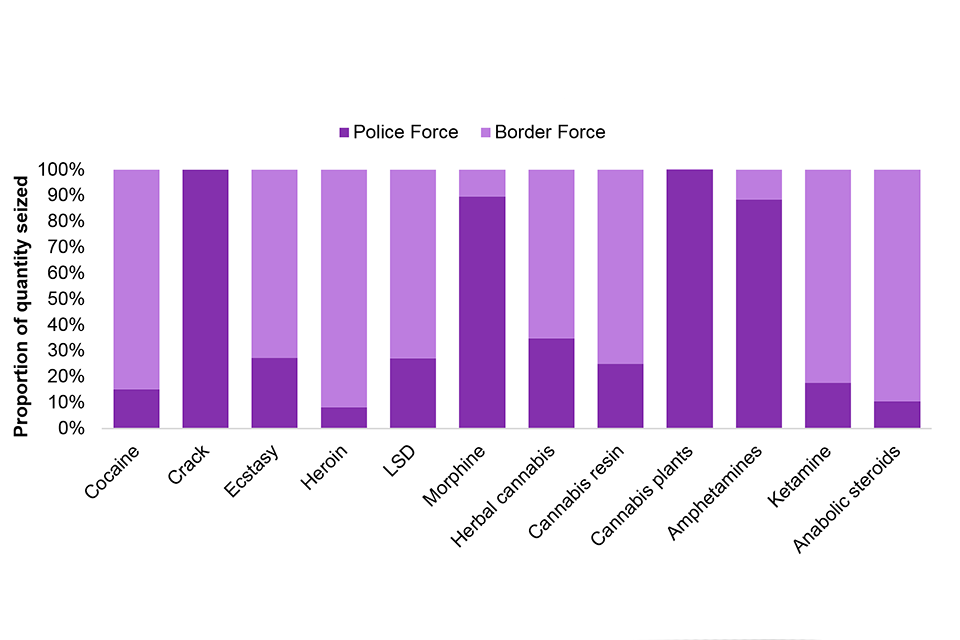
Source: Home Office, Summary Table 5.
In general, Border Force seized much larger quantities of drugs, per seizure, than police forces. For drugs measured in grams, 26% of seizures by police forces weighed under 1g, compared with 2% of seizures made by Border Force. For drugs measured in doses, 79% of seizures by police forces involved fewer than 50 doses, compared with 61% of seizures made by Border Force. A further breakdown by drug type is provided in Figure 16 to Figure 19.
Figure 16: Distribution of drug seizure quantities of cocaine by authority, year ending March 2021

Figure 17: Distribution of drug seizure quantities of heroin by authority, year ending March 2021

Figure 18: Distribution of drug seizure quantities of herbal cannabis by authority, year ending March 2021
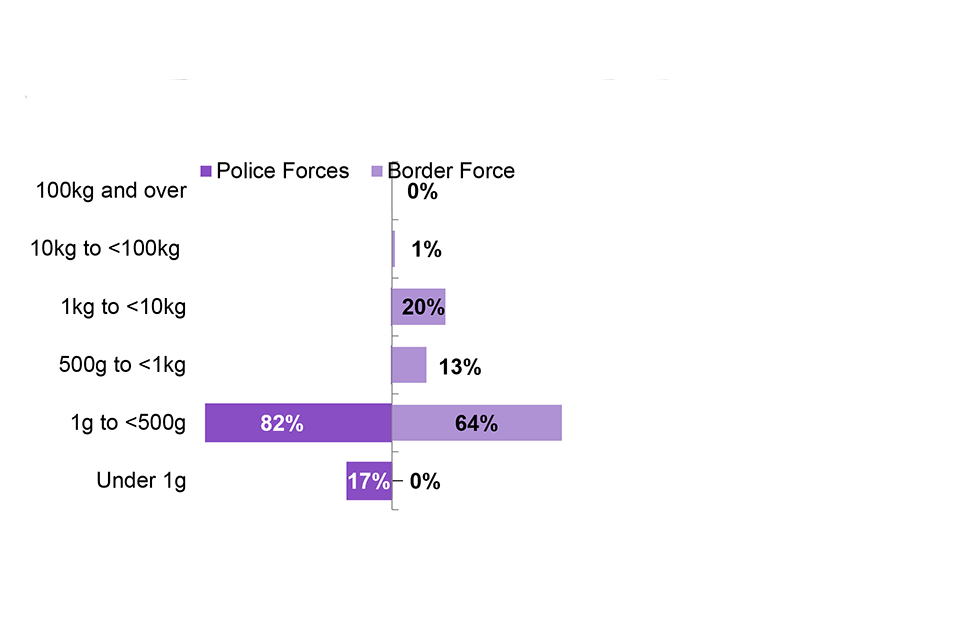
Figure 19: Distribution of drug seizure quantities of ecstasy by authority, year ending March 2021

Source: Home Office, Summary Table 3. Numbers may not sum to 100% due to rounding. In Figure 19, Border Force’s numbers do not sum to 100% because only 377 out of a total of 803 of Border Force’s ecstasy seizures were recorded in units, and the remaining ecstasy seizures were recorded in kilograms and therefore do not fit under one of the quantity bands.
5. New psychoactive substances
NPS refers to newly available drugs that mimic the effect of existing drugs such as cannabis, ecstasy, and powder cocaine. Some NPS are controlled under the Misuse of Drugs Act 1971 (MDA). Other types of NPS may be illegal to supply, produce and import under the Psychoactive Substances Act (PSA) 2016. In the year ending March 2018, figures for seizures of NPS were presented in this publication for the first time. Data is presented for years ending March 2020 and 2021, however these statistics remain as designated Experimental Statistics, as they are not yet fully developed and do not meet the rigorous quality standards of Official Statistics.
Seizures of NPS have been grouped into four categories: nitrous oxide, NPS powders, synthetic cannabinoids and NPS Other (including pills). Seizures of synthetic cannabinoids are also counted against the ‘Other Class B’ category, as the ‘third generation’ of synthetic cannabinoids were controlled as Class B substances in December 2016. See the Explanatory Memorandum, Home Office, 2016.
5.1 Number of NPS seizures
- there were 3,289 seizures of NPS by police forces in the year ending March 2021, an 18% increase from the previous year (2,794)
- Border Force could not provide separate figures for total NPS and synthetic cannabinoids seizures in the year ending March 2020, so comparisons to the previous year are not included; for year ending March 2021 there were 815 seizures of NPS by Border Force
- as shown in Figure 20, synthetic cannabinoids were the most frequently seized category of NPS (2,162 seizures by police forces); this is a 3% decrease from 2,093 police force seizures in the previous year
- the number of seizures of NPS powders by police forces and Border Force increased by 40%, from 255 to 357, and nitrous oxide seizures increased by 36%, from 274 to 373 seizures
- seizures of NPS Other increased by 88%, from 649 to 1,220 seizures, between the years ending March 2020 and 2021
- police forces were responsible for 84% (314) of nitrous oxide seizures, 53% (640) of NPS Other seizures and 49% (173) of NPS powder seizures
Figure 20: Number of NPS seizures by drug type and authority, years ending March 2020 and 2021
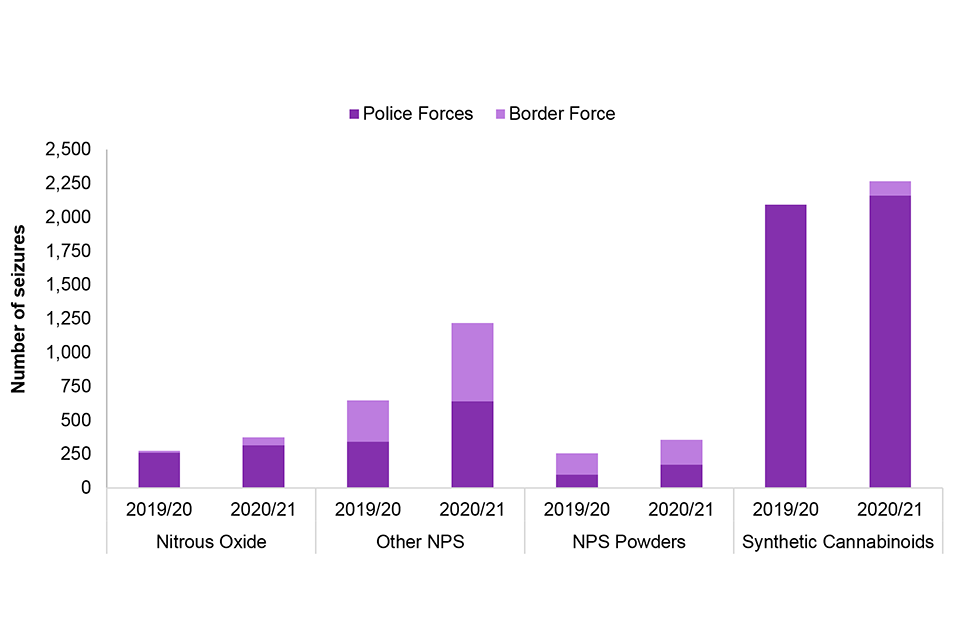
Source: Home Office, Appendix Table 1
Chart notes Synthetic cannabinoids figures exclude Border Force seizures for year ending March 2020, so these figures are not directly comparable.
5.2 Quantity of NPS seizures
The quantities of drugs seized are summarised in terms of kilograms for NPS powders and are summarised in doses for nitrous oxide. NPS Other seizures and synthetic cannabinoids have been presented with separate figures for kilograms and doses.
- a total of 2.12 million doses of nitrous oxide were seized by police forces and Border Force in the year ending March 2021; this comprised 69,650 doses seized by police forces, and 2.05 million doses seized by Border Force, the latter being 97% of the total (Figure 21)
- Border Force could not provide separate figures for synthetic cannabinoids seizure quantities, in the years ending March 2020 or 2021
- the quantity of nitrous oxide seized by police forces in 2021 (69,650 doses) was 30% higher than that seized in the year to March 2020 (53,583 doses); in the year to March 2020, Border Force seized 258,637 doses of Nitrous Oxide, so the 2.05 million doses seized in the year to March 2021, represented a 693% increase
- as shown in Figure 22, a total of 32,161 doses of NPS Other were seized by police forces and Border Force in the year ending March 2021, of which 17% (5,335 doses) were seized by Border Force, and 26,826 doses were seized by police forces; the police seizures of NPS Other increased by 391% (from 5,464 doses in the year to March 2020); Border Force seizures decreased by 72% (from 24,638 in the year to March 2020)
- as shown in Figure 23, a total of 568kg of NPS Other were seized, this is a 472% increase from the previous year (99kg); most of these seizures were by Border Force (99%, 563kg)
- also shown in Figure 23, police forces seized a total of 29kg of synthetic cannabinoids in the year ending March 2021; this is a 52% decrease from the previous year, when police forces seized a total of 61kg; Border Force totals for synthetic cannabinoids quantities seized, were not available for 2020 or 2021
- a total of 297kg of NPS powders were seized in the year ending March 2021, a 46% increase from the previous year (203kg); Border Force seized 99% of these; Border Force seizures increased 50%, from 195kg in the year to March 2020, to 294kg in the year to March 2021; police forces seized 8kg in the year to March 2020, but 3kg in the year to March 2021, a 56% decrease (Figure 23)
Figure 21: Quantities of Nitrous Oxide seized (doses) by authority, years ending March 2020 and 2021
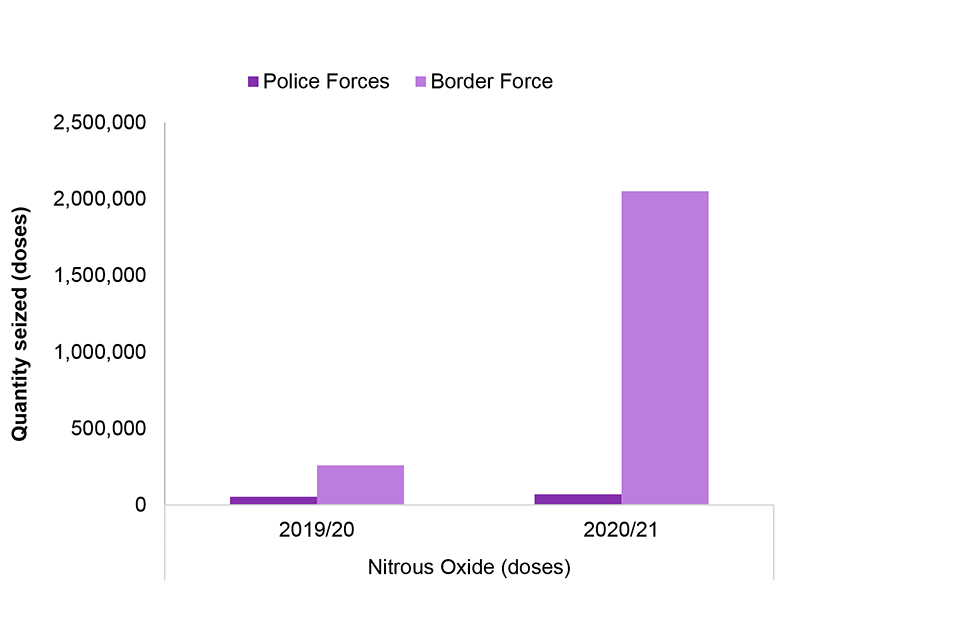
Source: Home Office, Appendix Table 2.
Figure 22: Quantities of NPS Other and Synthetic Cannabinoids seized (doses) by authority, years ending March 2020 and 2021
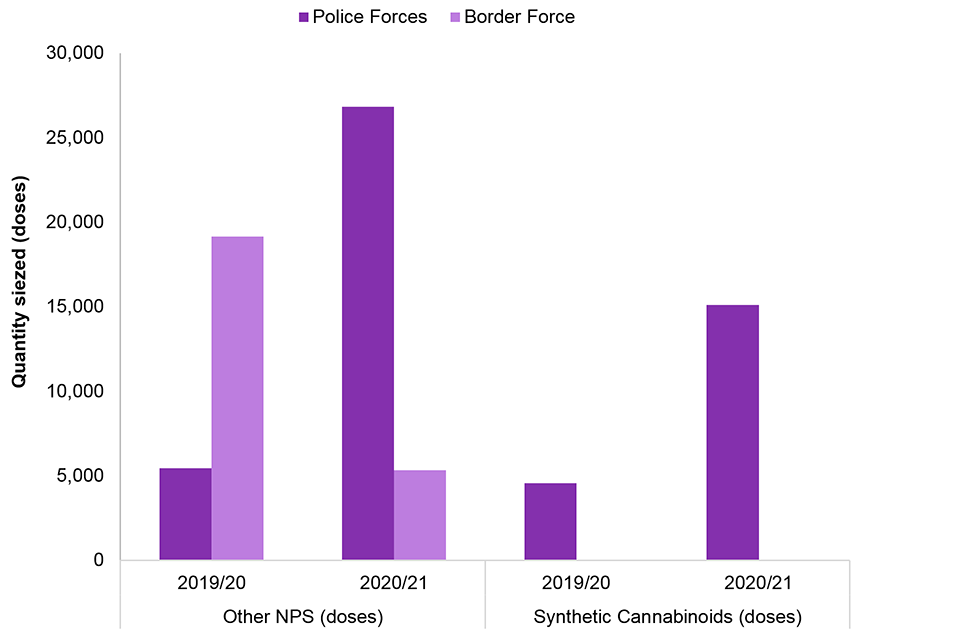
Source: Home Office, Appendix Table 2.
Figure 23: Quantities of NPS drugs seized by drug type and authority, summarised in kilograms, years ending March 2020 and 2021
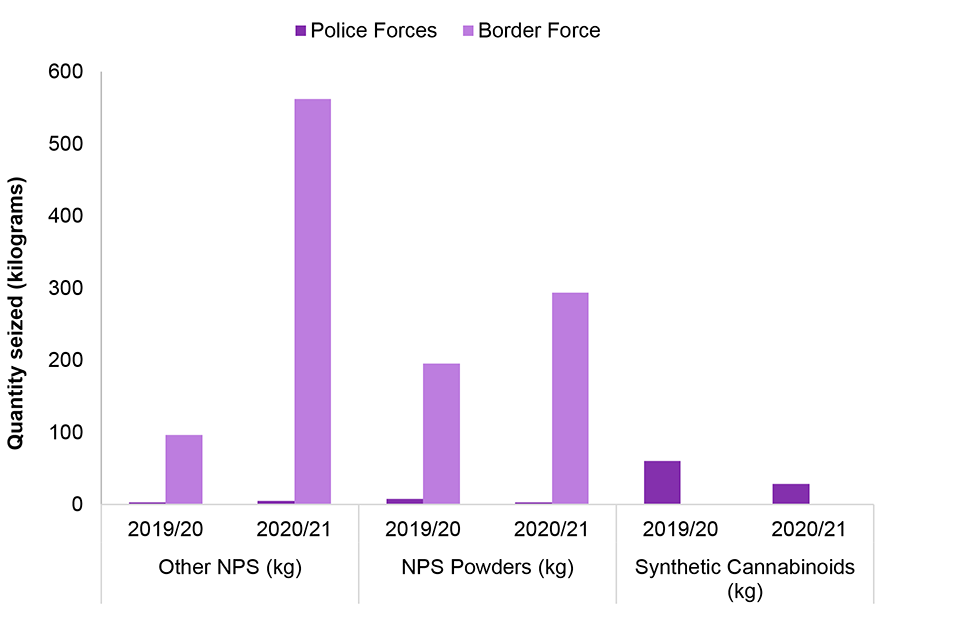
Source: Home Office, Appendix Table 2.
6. Data quality and interpreting the figures
The statistics in Seizures of drugs in England and Wales relate to the seizures of drugs controlled under Misuse of Drugs Act 1971 (MDA), which came into force on 1 July 1973, and the Psychoactive Substances Act (PSA) 2016, which came into force on 26 May 2016. They cover seizures made during the year by police forces in England and Wales (including the British Transport Police) and Border Force (formerly part of the UK Border Agency). Although Border Force will have made seizures outside the land territory of England and Wales (e.g. Scotland, Northern Ireland) such seizures are excluded from figures presented in the publication. Seizures from joint operations involving Border Force and the police are recorded against the lead agency that takes possession of the seized drugs.
Where a seizure is made of a drug not separately listed in this bulletin, it is aggregated into an ‘other’ category based on its class, for example ‘Other Class A’ for Class A drugs. Please see Schedule 2 of the MDA (Misuse of Drugs Act) 1971. This includes further information on drugs covered under the MDA, along with a link to the full list of drugs covered.
Details about the counting rules used for calculating numbers of seizures in this bulletin are included in the user guide.
6.1 Imputation
Three police forces (Hertfordshire Constabulary, Kent Police and Staffordshire Police) could not provide fully accurate data for the year ending March 2021, in time for the publication. As a result, data and imputation methods have been used to estimate data for these forces. Further information on estimations, including revisions to those made in previous years, can be found in the introduction of the user guide.
6.2 Revision policy
Police forces can resubmit historical data whenever they wish. All figures quoted in this release are correct at the time of publication and reflect the latest revisions made by police forces; therefore, figures published in this release supersede all previously published data.
It should also be noted that we improved our data processing and analysis methods for this year’s report, which has resulted in the discovery of some historical errors in earlier years’ data and estimates. We have corrected these errors, and therefore some of the previous years’ figures will differ from previous years’ reports. The user guide explains these changes further.
Data for Border Force are only revised once a year, the year after the period they refer to.
Further information on the data collection process, and quality assurance of the data, can be found in Appendix A of the user guide.
7. Other data sources
7.1 Seizures by police in Scotland and Northern Ireland
As well as providing a comparison to seizures in England and Wales, drug seizure figures for Scotland and Northern Ireland give a more complete UK-wide picture. Data relating to seizures of drugs by the police in Scotland are collected and published by the Scottish Government. The latest drug seizure statistics for Scotland were published on 23 November 2021, and are available online at: The Scottish Government website
Prior to the year ending March 2015, the Scottish Government used the same counting rules and broad methodology as for England and Wales. However, since then they have changed the data collection process, splitting seizures into supply and possession offences, and using extrapolation methods to estimate the latter from a sample. As a result, the figures from Scotland are not directly comparable with those from England and Wales.
The Police Service of Northern Ireland (PSNI) collects and publishes data on drug seizures by police in Northern Ireland, and they are also presented on the same basis as those for England and Wales. The latest drug seizure statistics for Northern Ireland are published quarterly. They are available online at: Police Service of Northern Ireland website
7.2 Border Force seizures
Seizures made by Border Force officials outside England and Wales (e.g. Scotland, Northern Ireland) are excluded from figures presented in this statistical release. A quarterly breakdown of Border Force seizures in the UK is available online as part of their regular key performance indicators, at Border Force transparency data.
7.3 Further sources relating to the misuse of drugs
The extent and trends in illicit drug use among adults aged 16 to 59 is measured by the Crime Survey for England and Wales (CSEW). The latest results covering the year ending March 2020 were published by ONS on 9 December 2020. According to the CSEW for the year ending March 2020, around 1 in 11 (9%) adults had taken any illicit drug in the last year, similar to the previous year (9%) and similar to over a decade ago (10% in the year ending March 2009 survey). Please see the latest versions of the Drug Misuse: Findings from the 2019 to 2020 CSEW, and the Crime Survey in England and Wales.
The Smoking, Drinking and Drug Use among Young People in England is published by NHS Digital and contains results from a biennial survey of school children aged 7 to 11. Based on the 2018 survey, 24% of pupils reported they had ever taken drugs. This was the same percentage as in 2016, and similar to the 2007 level, 25%.
